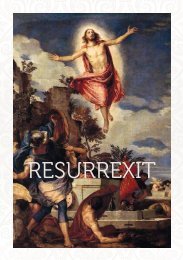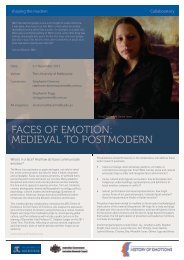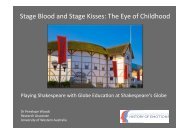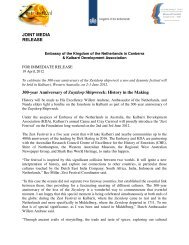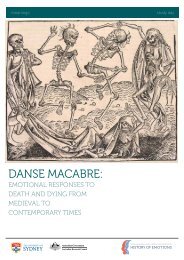Download our K-12 education pack - ARC Centre of Excellence for ...
Download our K-12 education pack - ARC Centre of Excellence for ...
Download our K-12 education pack - ARC Centre of Excellence for ...
You also want an ePaper? Increase the reach of your titles
YUMPU automatically turns print PDFs into web optimized ePapers that Google loves.
Year 4 – 6<br />
ACTIVITIES<br />
Early South African cultures<br />
Australian Curriculum<br />
ACHHS 081, 084, 085, 086, 098, 101, 104, 105 ACHHK 078, 080<br />
Context<br />
San - As the earliest known people in modern South Africa<br />
they did not have a term to refer to themselves. Traditionally<br />
hunter gatherers, they were called San by the Khoikhoi people,<br />
or Bushmen by the Europeans. A 2009 genetic study found the<br />
San are one <strong>of</strong> 14 known ‘ancestral population clusters’ from<br />
which all modern humans evolved.<br />
Khoikhoi – first recorded at the Cape 2000 years ago, the<br />
Khoikhoi (meaning ‘people people’) are distinct from the San<br />
as they had a more pastoral lifestyle. The Khoikhoi raised<br />
livestock which allowed them to live in larger and more stable<br />
groups than the San. The Khoikhoi had ongoing violent<br />
encounters with the European explorers, as the VOC cape<br />
settlement overtook traditional grazing lands and introduced<br />
diseases like smallpox to which they had no immunity. While<br />
the VOC settlers were not allowed to enslave the Khoikhoi,<br />
they still lost much <strong>of</strong> their independence, culture and<br />
language as servants on European farms in exchange <strong>for</strong> food,<br />
clothing, alcohol and tobacco.<br />
Afrikaners – Descended from Europeans <strong>of</strong> the VOC<br />
settlement, including Dutch Calvinists, French Huguenots, and<br />
German settlers. They speak Afrikaans, a modified <strong>for</strong>m <strong>of</strong><br />
Dutch with adopted vocabulary from Malay, German,<br />
Portuguese, Khoisan and Bantu languages. The first white<br />
person to identify themselves as an Afrikaner was Hendrik<br />
Biebouw in 1707, who stated ‘Ik ben een Afrikander’ (I am an<br />
African) when he resisted expulsion from the Cape, the first<br />
recorded sense <strong>of</strong> belonging to the territory <strong>of</strong> modern South<br />
Africa rather than a European homeland.<br />
Boers – a distinct group <strong>of</strong> the larger Afrikaners, the Boers<br />
were freemen who left the Cape colony during the nineteenth<br />
century to escape British rule. Originally called Voortrekkers<br />
as they trekked east<br />
For more in<strong>for</strong>mation<br />
See Stories <strong>for</strong> Teachers and Students 2013: Dancing into the<br />
spirit world; Frustrated negotiations; Claiming spaces, knowing<br />
places; Starry nights; Rainbow cuisine.<br />
Lesson Idea<br />
For a History lesson create a timeline <strong>of</strong> South African<br />
cultures, including first identified arrival and distinguishing<br />
cultural characteristics. The timeline should note that these<br />
cultures overlap; not exist exclusive to each other.<br />
For a History or English lesson, imagine you (with the<br />
assistance <strong>of</strong> time travel) are making a documentary <strong>of</strong> one <strong>of</strong><br />
these cultures. Identify what cultural characteristics should be<br />
recorded, and how you could capture this footage.<br />
For a History or English lesson, write a narrative <strong>of</strong> one event<br />
from two different perspectives. The two stories should<br />
demonstrate how an interaction is understood differently from<br />
two different cultural viewpoints.<br />
For a History lesson, compare and contrast the experiences <strong>of</strong><br />
the Khoikhoi with the experiences <strong>of</strong> an Australian Indigenous<br />
group. The comparison (in table or other <strong>for</strong>m) should include<br />
historical and modern characteristics, including housing,<br />
livelihood, health, language, population, family structures,<br />
origin beliefs, and interaction with European explorers.<br />
IMAGE/ Charles Davidson Bell (1813–1882), Jan van Riebeeck arrives in Table Bay in April 1652. S<strong>our</strong>ce: Suid-Afrikaanse Geskiedenis in Beeld (1989) by Anthony Preston. Bion Books.<br />
FAR FROM HOME: ADVENTURES, TREKS, EXILES & MIGRATION<br />
9





